by Winding Pathways | Nov 25, 2021 | Mammals, Nature, Preparedness, Uncategorized
Two years ago, hardly anyone knew what the novel Coronavirus was, but since then this crafty virus and the nasty disease it causes, COVID-19, has hardly been all over the news. Like most people we thought it was a disease of only humans.
We were astonished to learn that a high percent of Iowa tested deer has been found positive for COVID. With deer hunting season approaching we wondered if deer pose a threat to people either butchering an animal or eating the meat. So, we contacted Dr. Tyler Harms. He’s the Iowa Department of Natural Resources Deer Program Leader.
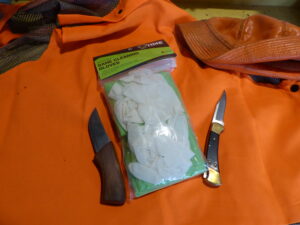
Dr. Tyler Harms, head of deer project in Iowa recommends safety gloves and hand washing when processing and preparing venison.
According to him the threat seems minimal, however, he recommends the following actions for anyone processing a deer:
- Wear rubber gloves when processing an animal.
- Wash hands and equipment thoroughly after handling deer meat
According to Dr. Harms, Iowa’s deer are asymptomatic. They don’t seem to be getting sick or dying.
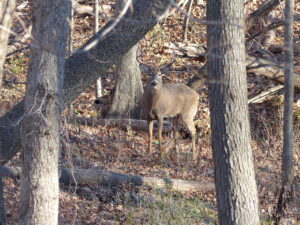
Bucks are still active in December.
December is Iowa’s main deer hunting season. Over 100,000 animals are likely to be harvested. Here at Winding Pathways, we enjoy venison as local, organic, free-range meat. But we’ll be sure to follow Dr. Harm’s advice when handling meat.
In many ways COVID is a mysterious disease. Where it came from remains a hazy mystery, and its variants continue to perplex people. Now it’s been found in animals. Iowa’s deer aren’t the only animals that test positive. The disease has been found in leopards in zoos and mink. It’s likely that many other animals and deer nearly everywhere carry COVID. How they got it and how it’s spread is a mystery.
by Winding Pathways | Nov 18, 2021 | Nature
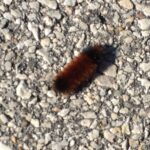
You see woolly bears crossing roads and drives.
When we walked out to our mailbox on a blustery early November afternoon, we learned we weren’t alone. A solitary woolly bear slowly inched its way across our driveway. It must have seemed like an endless walk for this intriguing creature.
Sometimes we struggle to coordinate our two legs, so we’re glad we don’t have 13 body segments like our woolly bear friend.
It gets cold in Iowa. Very cold. On some winters it’s been 25 below zero at Winding Pathways, so how do insects whose larvae emerge in the fall survive? Well, they have it figured out. The insect finds a safe place and just lets the freeze come. Their body actually freezes solid, and sometimes we find one tucked into our woodpile on a frosty winter morning.
Woolly bears’ larvae aren’t picky eaters. They enjoy snacking on many types of vegetation but don’t seem to do much damage. The slow-moving caterpillars of fall become Isabella tiger moths next year.
Can they predict how severe the coming winter weather will be? Probably not and they may not even care. They’ll spend winter frozen solid and worrying about nothing.
We love seeing woolly bears each fall and someday we may visit one of the five wooly bear festivals. They are held in Vermillion, Oh; Banner Elk, North Carolina; Beattyville, Kentucky; Oil City, Pennsylvania; and Little Valley, New York.
Woolly bears are always fun to see. Fortunately, they have a huge range across the northern part of North America.
-
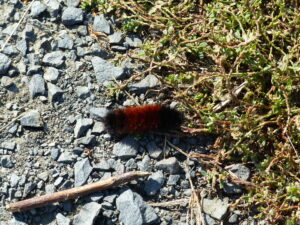
-
How do woolly bears coordinate 13 segments?
-
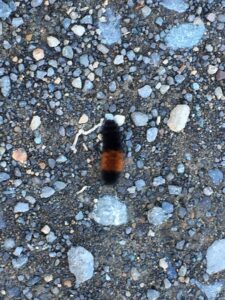
-
Woolly bears can be found as far north as the Arctic!
-
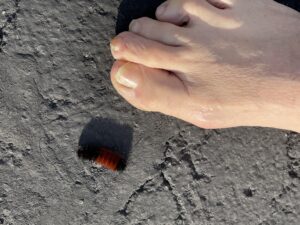
-
Woolly’s are tiny compared to a foot.
by Winding Pathways | Nov 11, 2021 | (Sub)Urban Homesteading, Birds, Garden/Yard, Nature
“A woodpecker is hammering on my house. It’s damaging my siding and driving me nuts. What can I do?” asked a longtime friend.
Woodpeckers often hammer on buildings, and we’ve taken dozens of calls from homeowners seeking relief. There are ways to discourage the plucky birds.
Woodpeckers bang on wood for at least three reasons:
- Drumming. Drumming on wood or metal in a rapid burst announces the bird’s presence to others. It is loud advertising.
- Nesting. Woodpeckers excavate cavities, usually in dead trees, to make a safe comfortable nest in the spring. A snug nest within an insulated wall is a great substitute for a tree.
- Food. Woodpeckers make their living dining on insects lurking in wood. Commonly this is a fall and winter activity, especially on home sided with rustic
T 111 plywood.
We love woodpeckers, and so do most people. But, no one wants damage to their home. So, how can it be prevented?
Prevention
It’s tough to stop drumming, but the good news is that it is usually of short duration in the spring and rarely damages the home.
It is difficult to stop birds from excavating a nest, but fortunately this is relatively rare. The long-term solution is to side the home with a durable hard material. Bricks are ideal.
Foraging may be the most common home damage. It can be extensive and comes with annoying noise as the bird removes wood to expose hidden bugs. Here are some solutions:
If building a new home, specify siding that lacks holes and cracks. If no insects can enter woodpeckers have no reason to try to extract them.
- With a caulking gun and putty knife plug every possible hole in the home’s exterior in late winter or early spring. This prevents insects from entering.
- If a woodpecker is foraging on a small section of the house draping light duty netting, the material sold to keep birds off cherry trees, will physically keep the birds away. Sometimes it can be stapled to an overhanging eve and to the siding below.
- Luring a bird away from the home may work. Erect a suet feeder 40 or 50 feet away from the house. The woodpecker might prefer eating easy-to-get suet instead of digging bugs out of the home.
-
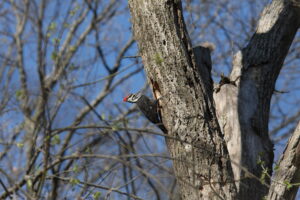
-
The Pileated woodpecker – Woody Woodpecker – is a sight to see!
-
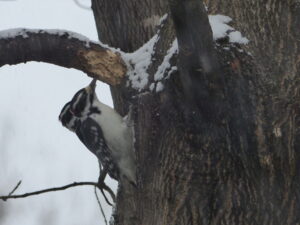
-
Woodpeckers dig for insects on trees.
-
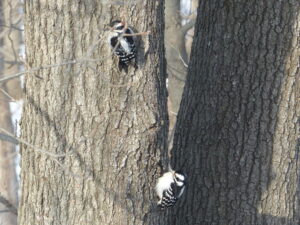
-
These woodpeckers are happy to forage for insects on a tree trunk.
Perhaps the best strategy for enjoying woodpeckers but preventing damage is to protect nearby dead trees. If a tree poses no falling threat to a structure, car, or person, leaving it in place gives woodpeckers a place to drum, nest, and find tasty insect meals.
Woodpeckers are amazing and beautiful animals that bring us joy. We are fortunate to have hairy, downy, red-bellied, red-headed, pileated, flicker, and sapsucker at Winding Pathways. They enjoy our feeders and leave the house alone.
-
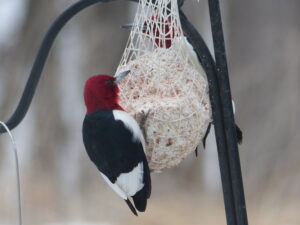
-
Woodpeckers would rather eat from a suet ball than drill on a house.
-
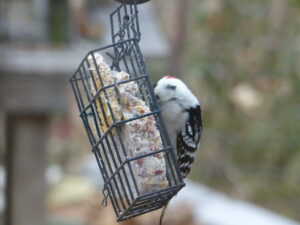
-
We’ve had all sorts of interesting woodpeckers at the feeders.
-
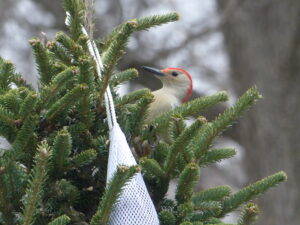
-
We tuck suet in Evergreen trees for the birds to enjoy.
by Winding Pathways | Nov 4, 2021 | Birds, Nature
What is a Bird Diva?
We’d only walked a short way when Bridget Butler stopped our small group. “Look at the top of that tree. See the bird,” she asked.
We did, and from long experience knew its species, but Bridget’s coaching helped us become better birders.
“Notice its size. Is it bigger/smaller than a sparrow”? (Bigger). Colors? (reddish/brownish).
Bridget was teaching us her method of slow birding. It’s an effective way to spot birds and figure out the species.
Slow Birding
We were in Vermont to attend the conference of the Outdoor Writer’s Association of America at Jay Peak ski resort tucked up near Canada. The Peak’s ashes, maples, and aspens were in glorious full color on the early October morning. Up early, we had met Bridget and other conference attendees in the hotel lobby.
Bridget slowly led us just past the parking lot, eyes and ears open for the slightest movement or chirp. We spotted and heard birds that a hasty walk would have bypassed.
What to Look and Listen For
Bridget’s suggestions for identifying a bird include:
Listen carefully. Often, it’s easier to distinguish a species by sound rather than sight. Close your eyes to help focus on sound.
Observe size. Compare the bird to common, landmark species. Is the bird bigger /smaller than a sparrow or robin or crow, for example?
Observe color/Patterns. Where is the most color on the bird? Are there eyelines, streaking on the breast?
Observe activity. Is the bird perched high in a tree or scurrying around in bushes? Is it solitary or in a flock?
Observe the habitat. Coniferous woods, hardwood forest, brush, grassy, marsh.
The bird we first spotted high in a spruce tree was a common American Robin, one of the most visible and recognizable of all birds. It provided Bridget with an example of how to help birding newcomers to learn species. And, was a reminder to experienced birders to slow down and observe more and be concerned less with adding to “the list.”
Various Habitats
Our walk took us from a mowed lawn through a dense sugar maple wood and around to a delightful pond at Jay Peak’s base. While in the woods a barred owl responded to Bridget’s call.
When we emerged from the woods to the open pond, we spotted a knot of ducks swimming on the far end. “Let’s walk slowly and see how close we can get,” she said. She suggested we avoid looking directly at the ducks – pretending that we didn’t know they were there. It worked! The ducks seemed unconcerned about our slow pace toward them yet instantly took flight when a jogger appeared on the other side of the pond.
Ring-Billed ducks! A thrilling sight as the colorful and agile birds winged against the backdrop of Jay Peak’s autumn splendor.
-
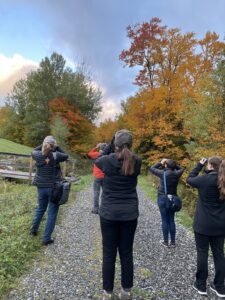
-
Pause to listen and look. Binoculars help.
-
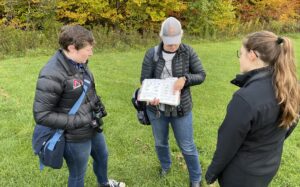
-
Bridget sharing identification tips with birders.
-
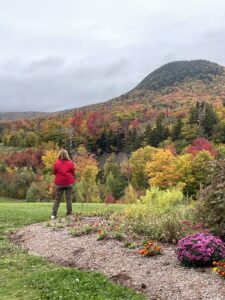
-
Varied elevations and habitats offered excellent birding.
Anyone heading for Vermont might want to join one of Bridget’s walks. If not, her slow birding technique works well anywhere. Her business is called Bird Diva Consulting. She leads bird walks, inventories birds, provides landowner assistance, and does presentations. Her website is birddiva.com.
by Winding Pathways | Oct 28, 2021 | (Sub)Urban Homesteading, Flowers/Grasses, Garden/Yard, Garden/Yard, Nature, Trees
A camera is an outstanding tool to see change. Plant a tree or prairie and it grows so glacially slowly that noting change is hard. Photos help by compressing time.
In August 2020 a derecho felled 47 of our 53 mature trees. We spent much of last fall converting them into firewood and piling up brush. Knowing that the land would be sunny after years of leafy shade, we planted a blend of savanna wildflowers last November.
The area didn’t change much from last fall until April of this year. Then nature put on a glorious show. Here are three photos of our yard taken in April, May, and September 2021. Most of the growth didn’t come from the seeds we planted last fall. Seeds long dormant in the soil sprouted with enthusiasm once they sensed the sun’s springtime warmth.
-
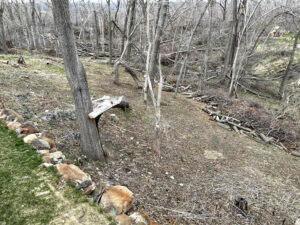
-
For over eight months the land lay waiting and still.
-
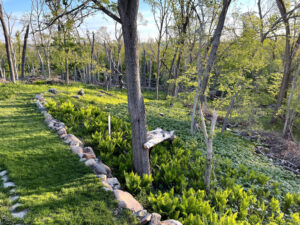
-
Ferns and Mayapple emerged strongly and yielded to more open woodland plants.
-
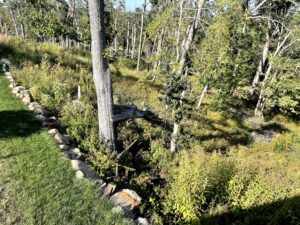
-
The seeds had waited dormant for the right conditions.


















